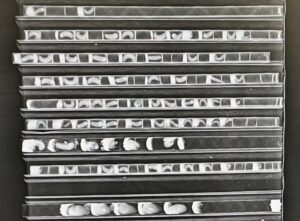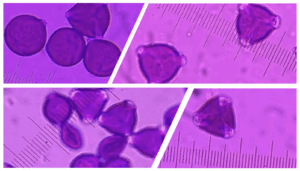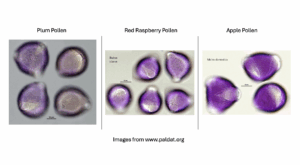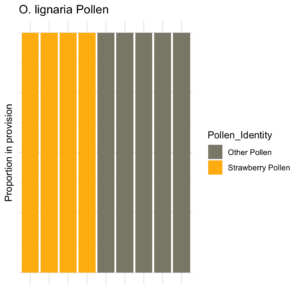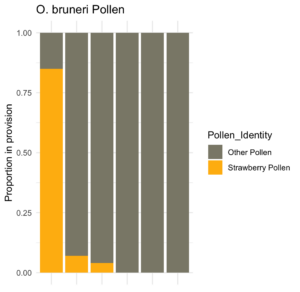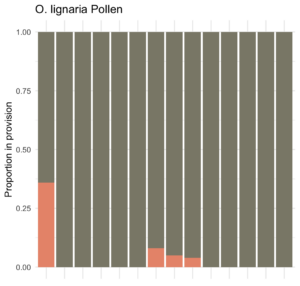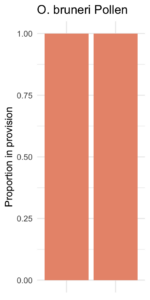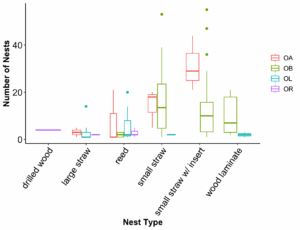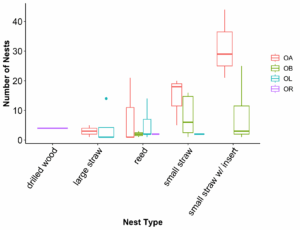Progress report for GW24-008
Project Information
Farmers struggle to achieve adequate pollination for many berry crops, possibly in part due to the heavy reliance on a single pollinator species: the honeybee. We propose the development of additional species of bees for managed pollination of berries. This will strengthen the sustainability of our food systems while supporting existing natural pollinator diversity, and the economic benefits derived will improve farmers' lives by increasing profits and easing burdens.
We will investigate the application of 4 lesser studied mason bee species on berry farms, all with some potential for berry pollination either shown through pilot study results, or previous scientific literature. We will determine if they pollinate a target crop by ID’ing the pollen in their brood provisions and comparing it to crop pollen samples. Additionally, we will test these bees' propensity to being managed for agriculture by evaluating their nesting success and estimating material and labor costs to maintain populations. Together these strategies will, 1) Identify which bee-crop pairings show potential for future development, and 2) Compose recommendations for cost-effective management strategies.
We will use targeted outreach to connect farmers with our research, including: university extension publications, short YouTube videos/tutorials, social media promotion, and presentations at grower meetings. We will partner with bee conservation-focused organizations to promote these materials to reach their respective memberships of largely bee managers and farmers (Orchard Bee Association) and backyard gardeners and bee enthusiasts (Oregon Bee Atlas) to, 1) Improve producer and beekeeper knowledge about mason bee management and its benefits and 2) Distribute discoveries about mason bee pollination of berry crops.
This final outcome of this project will be to, 3) Publish on the management potential of these mason bees in berry crop systems in a peer-reviewed journal.
Research Objective 1: Investigate the aptitude of 4 mason bee species to be managed in commercial berry crop production using pollen ID.
Research Objective 2: Examine the nesting material preferences of 4 mason bee species to cost-effectively balance material attractiveness with management constraints.
Education Objective 1: Increase knowledge about mason bee management and its benefits among farmers and beekeepers by producing 2 educational videos.
Education Objective 2: Distribute discoveries about berry pollination with mason bees to a broad audience of farmers, beekeepers, and backyard gardeners by publishing 2 factsheets.
Education Objective 3: Publish a peer-reviewed paper on the management potential of the 4 mason bees studied in berry crops.
Cooperators
- - Producer
- (Researcher)
- - Producer
Research
We researched crop pairings to determine which of the candidate bees are apt to pollinate which berries (Research Objective 1). Then, we evaluated candidate bees’ preferences for nesting habitats by analyzing their nesting rates over the field season (Research Objective 2).
Research Objective 1: Investigate the aptitude of 4 mason bee species to management in commercial berry crop production.
We determined which bee-crop pairings have the most support for future management at the commercial scale by testing each mason bee species in multiple berry crops, and determining if they collect crop pollen by sampling the provisions they provide in their nest straws.
In our first field season, we tested 4 Osmia bee species: Osmia bruneri, Osmia aglaia, Osmia ribifloris, and Osmia lignaria on different berry crops (Table 1)
Currants - O. bruneri, O. lignaria, and O. ribifloris
Pollen analysis data from our pilot study in 2023 suggested that O. bruneri may selectively provision nests with currant pollen. In 2024, O. bruneri nesting was much lower than expected due to poor vigor in the bees. We were not able to achieve much emergence in currant fields, but still collected some pollen. We released O. lignaria, and nesting was low, but we sampled pollen from 17 total nests. After these initial findings, we chose to look more closely at certain provision samples in strawberry and currants. We determined proportions of pollens collected within each provision by randomly sampling from the 4 quarters of each pollen slide at 40x and using a clicker counter to tally pollen types into two categories: Crop pollen and non-crop pollen. Because of low bee numbers reared during 2023, we chose not to test O. ribifloris in currants, and use the limited stock to test their abilities in blueberries.
Strawberries - O. lignaria, O. aglaia, O. bruneri
We placed O. lignaria and O. bruneri in a strawberry high tunnel in northern Utah to test their effectiveness as high tunnel strawberry pollinators.We collected and analyzed this site's provisions for proportions of collected pollens using the quadrant counting method used above.
Blueberries - O. ribifloris
Osmia ribifloris is known as an Ericaceae specialist and is an efficient pollinator of the related rabbiteye blueberry (Sampson and Cane, 2000). Select research has shown that they readily pollinate Highbush blueberries and nest abundantly (Torchio, 1990). In 2023, we released O. ribifloris at a small diversified berry farm in Utah with limited blueberry acreage and saw little nesting.
In 2024, we placed O. ribifloris in high-acreage blueberry fields in Oregon.
Raspberries - O. bruneri and O. aglaia
Osmia bruneri and O. aglaia are both summer flying bees that emerge with the blooming of red raspberries (early to mid-June in Northern Utah). While O. aglaia is a potentially productive raspberry pollinator in commercial fields, Osmia bruneri has only been tested on the berry in limited caged studies (Andrikopolous et al., 2018) and provided us an opportunity to test this application for the first time.
We discovered through talking with extension agents and growers that red raspberry is not a large export in Oregon, so we decided to place Osmia aglaia on black raspberry in Oregon (2 sites) and pair that with 1 black raspberry site stocked with Osmia bruneri and Osmia lignaria in Utah. In Utah, where red raspberry is more economically important and more commonly grown, we also maintained two red raspberry sites with Osmia bruneri and Osmia lignaria (Table 1).
Methods:
Site Selection
We worked to identify suitable fields and partner growers for each crop throughout the winter of 2023/2024. We reached out to growers that we had already worked with (currant, strawberry, blueberry, and raspberry growers in Utah), and identified new growers through our supporters at Utah (Dr. Brent Black) and Oregon State University (Dr. Andony Melathopolous) (see letters of support).
Table 1: Bee-crop pairings tested and our levels of field replication in each state tested in 2024.
OB = Osmia bruneri, OA = Osmia aglaia, OL = Osmia lignaria, OR = Osmia ribifloris
| Currants | Strawberries | Blueberries | Black Raspberries | Red Raspberries | Boysen Berries | |
| Bee | OB, OL | OB, OA, OL | OR | OA, OB | OB | OA |
| Utah | 2 | 1 | 1 | 1 | 2 | 0 |
| Oregon | 0 | 0 | 6 | 2 | 0 | 1 |
*Osmia bruneri has been managed for research projects at the USDA ARS Pollinating Insects Research Unit (home institute of the project PI, Dr. Graham) since the 1980s. We had enough bees in management to fulfill the needs of this project at no cost.
**Osmia lignaria, O. ribifloris, and O. aglaia bees were purchased from our collaborator Kimball Clark, who manages and sells them.
Field Work
Selected sites were monitored for the start of bloom and bee condos (nesting substrates) were placed when buds appeared in Utah and at 10%-50% bloom in Oregon. We monitored the sites closely at this stage and the bee condos were stocked with bees of our target bee species at 10% - 50% bloom.
During the first week the bee condos were placed, a pollen survey was conducted. Pollen from flowering plants within the immediate field radius of the nesting shelter site was sampled and the exact location of the pollen sample with a determination of the plant species was curated using iNaturalist. Collected samples were used to create a pollen reference library out of microscope slides of dyed pollen grains. While our original plan was to collect from 300m around fields, further evaluation of pollen samples collected in 2023 revealed weaknesses in the methods. Wild plant references from 2023 were difficult to make use of (not much pollen available, and failure to match what bees collected). So, we instead focused on collecting from plants that were highly abundant directly within or around berry fields, and pollen was ID'd mainly using references of just the crop pollens. This way we determined if the bee was pollinating berry crops, but many non-crop pollens were not identifiable.
Regular site visits during bloom were conducted. At each visit, we removed and replaced any finished nest straws and sampled their pollen provisions (described below).
Pollen Analysis
At the lab, we took X-rays of the collected straws. The X-ray image of the nest tube was used to locate and count the brood cells (Image 1). We randomly selected brood cells (usually one per nest) for pollen analysis and then carefully cut a window through the nest and into the cell, avoiding the larva. The pollen provision was then sampled, and the window taped shut and the pollen sample given a unique sample ID. Provision samples were processed into slides of dyed pollen grains and were identified as either crop pollen or "other" using the reference library of crop pollens.
Image 1: X-ray image of Osmia nests pulled from a project site in 2023. Nests are arranged side-by-side.
Taken together, these data provided us with information on nesting rates and pollen preferences of each bee species at each crop.
As Desribced above (Currants section), we also looked in-depth at the proportion of pollen types collected for strawberry, classifying them as their crop pollen or "other" non-crop pollens, allowing us to compare the amount of loyalty shown for different pollens between two of our bees: Osmia lignaria and Osmia bruneri.
Data analyses
Much of our data were observational, such as the percentage of crop pollen collected, and bee nesting returns. One of the most important results is establishing if each bee species will (or will not) collect crop pollen; a vital first step in determining if they are viable for managed pollination. We also needed to determine if the bees are nesting at high enough rates to indicate that they are actively visiting the crops in that field and if they can be managed sustainably. Sufficient nesting is needed to make the system feasible long-term, as nests provide the bees used for the following year. We therefore set a target bee return rate of 100%, a measurement common in the mason bee industry to indicate system sustainability, as it explains that the number of viable brood collected at the end of the field season is equivalent to or higher than the number of adults released initially.
In addition, we were interested in testing whether field type has an impact on nesting success and pollen collection. For example, Do larger acreage crop fields result in more or less nesting by each species? So far, nesting rates have been too low and variable to use statistical analysis in determining if species’ pollen collection or nesting rates are based on the field type. We hope that this year the nesting is more productive and we can run these analyses.
Research Objective 2: Examine the nesting material preferences of 4 mason bee species to cost-effectively balance material attractiveness with management constraints.
Rationale:
While promising for pollination, mason bees present unique challenges to bee managers. Honeybees inhabit large interdependent social networks contained in bee boxes. Female worker bees are generally unable to reproduce and are thus dependent on the survival of a hive-stuck queen for reproductive success, solidifying evolutionary-driven cooperation. In contrast, Osmia are solitary bees, where each female is reproductively capable and forms nests independently. This makes the solitary bee more efficient on a per-bee level, as a single female bee will collect more pollen than a honeybee as the sole provider for her nesting brood (Lyu et al., 2023). That said, this independence makes managing solitary mason bees a very different task compared to communal honeybees, and thus increased attention is needed to understand mason bee proclivities to existing and novel strategies for management.
We therefore analyzed the nesting material preferences of mason bees systematically to optimize nesting returns. We set out bee condos (used in Research Objective 1) with a variety of materials historically used in rearing Osmia lignaria (reeds, straws, and wood laminates). Each material was provided in the ideal diameter for our small (1.5-3mm thorax width) bees, O. aglaia and O. bruneri, and our large (3-5mm thorax width) bees, O. ribifloris and O. lignaria. We then monitored their nesting rates in each substrate type to determine preferences for each species. And, while nesting material preferences are important in teaching us how to encourage high return rates (number of brood per adult released), they must be grounded in realistic management considerations to be useful to bee managers. We originally aimed to determine the labor and monetary costs of each material to identify a balanced approach to nesting material recommendations, taking into account both the bee preferences and the price of each nesting material. Unfortunately, we received no nesting in wood blocks in 2024, so plans to understand variable labor requirements were not feasible, but are planned for 2025 if nesting rates increase.
Methods:
Nest design
Bee condos were designed to provide nesting options within the optimal diameter range for each bee. There were two condo versions, one for large bees and one for small. Each had reeds, wooden laminates, and paper straws as nesting material options.
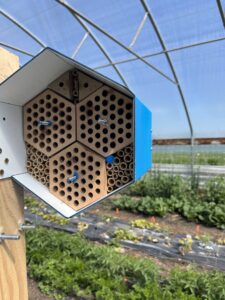 Image 2: Bee condo design: Wood laminates (Upper left and lower hex), black-painted paper straws (upper right hex), and reeds (gaps between hexes), (design: Kimball Clark, nativebees.com).
Image 2: Bee condo design: Wood laminates (Upper left and lower hex), black-painted paper straws (upper right hex), and reeds (gaps between hexes), (design: Kimball Clark, nativebees.com).
Nest preference evaluation
Removing capped nests regularly in cooperation with Objective 1 allowed us to catalog what types of nesting material are preferred by the nesting females of each species. Replacing capped nests with empty nests of the same materials ensured that nesting options always remained available. We counted the total capped nests at each site, evaluated preference per bee species, and examined total nest counts for each nesting material type, each bee species, and each crop.
We further attempted to evaluate the practicality of management based on material preferences by calculating the cost of each species’ utilized materials. Material costs were expressed as a sum of the cost of materials purchased in bulk and the cost of labor to process and rear out bee cocoons nested in those materials. To understand the cost of materials, Kimball Clark (bee producer) provided some basic financial data on material purchase and manufacturing costs. OUr next steps would be to then track the number of hours it takes to process each material, from receiving the nest to cleaning it to storing it for the winter months, to understand the labor contribution to the total cost of management per material. The compiled costs would then be compared with the bees’ preferences, and the most cost-effective management strategies would be determined and ranked.
Because we had no nesting in wooden laminates in 2024, we were unable to gather useful data on labor costs, but we did trial methods and will use these next year, assuming nesting is more successful. We also spoke with larger scale Osmia bee producers to understand costs on a broader scale (beyond the local vendor we work with).
Data analyses
To assess if bee species have nest material preferences (data: counts of completed nests in each material), we used generalized linear mixed effects modeling (R package lme4). Each bee species was analyzed separately. Models had a binomial distribution. Nesting material and crop were included as interacting factors for bee species tested on multiple crops (O. lignaria, O. bruneri, O. aglaia), with just nesting material included as a factor in the model for O. ribifloris (tested in blueberry fields only). We included the study site as a random effect.
Research Objective 1: Investigate the aptitude of 4 mason bee species to be managed in commercial berry crop production using pollen ID.
Objective 1:
We gathered pollen from berry farms in Utah and Oregon (See methods, Table 1). Osmia bruneri, O. aglaia, and O. lignaria were placed in red and black raspberry fields, and fairly strong associations were observed in their pollen collections (74%-100 % of provisions containing caneberry-type pollens). This is a promising intial result, but it is complicated by the uncertainty of morphological pollen identification. As seen in Figure 1, many pollen types resemble raspberry and blackberry pollens, but could be other pollens in the Rosaceae family (apples, pears, cherries, etc.). Because of their morphological similarities with other pollens, we classified provisions as containing pollens of "raspberry-type" pollen, instead of raspberry pollen.
Figure 1:
A. Distinct raspberry "type" pollens collected from Osmia bruneri provisions.
B. Common Rosaceae pollens that are difficult to morphologically distinguish.
A.
B.
Table 2: Summary of samples from Osmia bruneri provisions in 2024
| Crop | Black Raspberry | Red Raspberry | Currant | Blueberry |
| High nesting activity during bloom? | yes | yes | no | no |
| Total Pollen Samples | 35 | 22 | 33 | 2 |
| provisions with crop-type pollen | 29 | 22 | 1 | 0 |
| provisions without crop-type pollen | 6 | 0 | 32 | 2 |
| % of total with crop-type pollen | 82% | 100% | 3% | 0% |
Osmia bruneri collected 82% black raspberry type pollen, and 100% red raspberry type pollen. In contrast, very little currant, and no blueberry pollen was collected by O. bruneri in 2024. For currants, this was a stark contrast to 2023, where we found currant pollen in the 2 O. bruneri provisions. This year however, we had trouble emerging Osmia bruneri early in the season, so much of the nesting observed (30 of the 33 samples) were collected outside of the peak bloom window for currants. A collaborator later tested O. bruneri vigor in the lab, and found that many bees were too weak from the previous season to emerge from straw nests. Thus, we suspect that many of our bees failed to emerge at all. We believe we have addressed the issue that caused poor vigor, and will be releasing bruneri in loose cocoons this year (this is industry standard practice for other Osmia) which we suspect will increase emergence success.
Table 3: Summary of samples from Osmia aglaia provisions in 2024
| Crop | Black raspberry | Boysenberry |
| High nesting activity during bloom? | yes* | yes |
| Total Pollen Samples | 49 | 24 |
| provisions with crop-type pollen | 36 | 23 |
| provisions without crop-type pollen | 13 | 1 |
| % of total with crop-type pollen | 74% | 96% |
*trailing end of bloom (~70% spent)
Osmia aglaia collected 74% black raspberry type pollen and 96% boysenberry type pollen. This is in-line with our expectations from the literature, but concerns with morphological ID (Figure 1) should be considered before being too sure about these hopeful results.
Table 4: Summary of samples from Osmia lignaria provisions in 2024
| Crop | Strawberry | Currant | Red Raspberry |
| High nesting activity during bloom? | yes | yes | yes |
| Total Pollen Samples | 10 | 17 | 1 |
| provisions with crop-type pollen | 4 | 1 | 1 |
| provisions without crop-type pollen | 6 | 16 | 0 |
| % of total with crop-type pollen | 40% | 6% | 100% |
Osmia lignaria collected entirely raspberry-type pollens in 2024. Among 17 samples from currant fields, 1 was identified to be currant-type pollen. Re-analysis of 2023 pollen also revealed that 3 of the 14 nests O. lignaria nests also contained currant-type pollen.
Additionally, they flew well in a Utah strawberry high tunnel, collecting strawberry pollen in 40% of provisions. We were able to do approximate measures of %pollen types within provisions as well. We used these approximations to understand how loyal each bee was to collecting strawberry pollen in the high tunnel. We compared these provisions with the 2023 O. bruneri provisions to show the difference in collection patterns (Figure 2). From 10 pollen provisions, we observed consistent collection from Osmia lignaria in 40% of provisions. While Osmia bruneri from 2023 collected pollen in 50% of provisions, overall, they collected less proportional crop pollen when compared to O. lignaria.
Figure 2: Osmia provision pollen types from a strawberry high tunnel in Utah.
We were able to make a similar comparison by looking deeply at the currant pollen collected by O. lignaria (in 2024) and O. bruneri (in 2023). We observed that O. bruneri shows a stark pattern in currants, collecting provisions with 100% currant pollen, whereas in this crop, O. lignaria tended to mix pollens when it collected any currant at all (Figure 3).
While these patterns are constrained by low sample numbers, the collecting habits of Osmia appear to differ by species-crop interactions. Some species are satisfied with one pollen for provisioning, and others collect a diversity of pollens to fill their brood’s nutritional needs. This response appears to be plastic, with a single bee species behaving differently depending on the identity of the crop available.
Figure 3: Osmia provision analysis form 2 Utah currant fields (currant pollen proportion is displayed in pink/plum, non-currant pollen in gray).
Table 5: Summary of samples from Osmia ribifloris provisions in 2024
| Crop | Blueberry |
| High nesting activity during bloom? | yes |
| Total Pollen Samples | 15 |
| Samples with crop-type pollen | 15 |
| Samples without crop-type pollen | 0 |
| % of total with crop-type pollen | 100% |
Osmia ribifloris bees placed in blueberry fields in Oregon largely dispersed, but one successful nest site located in an organic field provided 4 total nests from which 15 samples of pollen were taken and identified. All of these were majority blueberry pollen. Bees from this successful site had "good returns." In other words, we got 48 bee brood cocoons after releasing ~45 adults, indicating a 107% return. Bee managers want to see >100% returns to maintain and grow their managed populations. While promising, results were largely limited due to the low quantity of bees offered to us by our bee manager collaborator. Interestingly, our successful site was the only one placed near organic fields. We are still placing nests in conventionally managed fields this year, but placing them near semi-natural habitat, farther from field. Hopefully, this will minimize exposure to conventional pesticides and increase site attractiveness.
Research Objective 2: Examine the nesting material preferences of 4 mason bee species to cost-effectively balance material attractiveness with management constraints.
Figure 4: Nest counts per material type, separated by bee species. OA = Osmia aglaia, OB = Osmia bruneri, OL = Osmia lignaria, OR = Osmia ribifloris for both years
Figure 5: Nest counts per material type, separated by bee species. OA = Osmia aglaia, OB = Osmia bruneri, OL = Osmia lignaria, OR = Osmia ribifloris for only 2024
Nesting rates regardless of material differed greatly by bee species, so we were not able to compare preferences between species responsibly. Additionally, differences between this year and last were significant, so we were not able to group years of data. Model fit to Poisson was unsuccessful and after re-evaluating the shape of the data, we decided to use another approach and will be applying a multinomial model in the near future.
For general costs of each material, we broke down the cost per nesting cavity provided to the bees. Kimball Clark reported that per nest cavity costs for phragmites or bamboo reeds is 10 - 25 cents, for Maple wooden laminates it is around 83 cents, but for a one-time purchase that can be reused. Because we had no nesting in most of our drilled wooden laminate shelters in 2024 (figure 5) we were not able to appropriately test the time it takes to clean and process wood laminate nesting materials, so we could not compare costs with labor need.
We connected with other Osmia producers and the Orchard Bee Association’s annual meeting. Here, we toured commercial bee production facilities and observed the industry technology used to efficiently process Osmia bees for large scale management. At this large scale, we have determined that wooden laminates are by far the most economical choice, as technology has been developed to process them en mass reducing labor costs substantially. The reusability of the wooden laminates is also important, with many of them being reused indefinitely. We will still pursue the labor analysis next year for the information it may provide to smaller bee management operations, but a scalable model for our other materials options seems to be clearly unable to match the efficiency and ease of using wooden laminates.
Research Outcomes
Objective 1:
Our research exploring the pollen collecting tendencies of 4 Osmia species has revealed stark differences in their affinities to different berry crop flowers. These findings highlight the importance of understanding this genus of manageable bees on the species level, and being conservative with recommending the primarily used pollinator (Osmia lignaria) for every crop system. From pollen identification of bee provisions two things have become clear - first, different bee species collect different berry pollens at distinct rates. Second, the amount of loyalty to a crop flower differs based on bee species, so that even when bees will collect from a crop flower, it may be less than 10% (Osmia bruneri in strawberry for example) of their total pollination for the day, or up to 100% (Osmia ribifloris in blueberry).
We recommend that further research in this area is conducted, especially with the lesser managed bees of the genus (Osmia ribifloris, Osmia agalai, Osmia bruneri, from this study, among others). We also recommend molecularly identifying sub-samples of pollens to ensure that morphological identifications can be trusted (in the case of identifiable pollens for currants, blueberries, and strawberries) and that morphologically indistinct pollens (raspberry, blackberry, black raspberry, and boysenberry) are being correctly identified and not being mistakenly assigned.
Lastly, we found that two Osmia species (O. bruneri and O. lignaria) pollinated and nested within an open-ended high tunnel. In the case of ever-bearing or day-neutral strawberries, bloom in high tunnels can last from early spring to early fall, so providing a bee that can fly longer periods in the variable weather conditions of the high tunnel without becoming fatigued or dispersing is vital. We think both O. bruneri and O. lignaria could be utilized for the two environmental extremes experienced in high tunnels (the early spring bee O. lignaria for early cool temperatures and overcast weather, and summer flying O. bruneri for high humidity and heat). Strawberry pollen analysis also revealed fascinating patterns in pollination loyalty. O. lignaria may be the best pollination option for this system because of their collection of strawberry pollen and their ability to fly in the cooler temperatures experienced early on in the bloom period.
Objective 2:
Variable nesting rates in our bees surprised us, especially with the commercially managed Osmia lignaria. We found that, at most sites, returns for O. lignaria and O. ribifloris were under 100%. The typical management strategy to promote population growth is to allow bees a year to nest in completely natural habitat, in between years spent on farms. While we initially thought increasing the attractiveness of nests would reduce the need to supplement Osmia populations, it has becoming clearer that we need consider nutrition and nesting materials provided by the surrounding habitat. There are positive associations between native bee abundance and semi-natural habitat (Eeraerts et al., 2021, 2022; Lundin et al., 2017; Gibbs et al., 2016). While we focused on nesting cavity material options initially, we now believe that the partition material access may be just as vital. Placing bees near or within areas adjacent to crop fields with natural vegetation and undisturbed soil may give bees easy access to leaf and/or mud used in the internal construction of cavity nests, prompting them to stay at a nest shelter.
We intended to look at the economics of nesting materials directly using cost benefit analyses and quantifications of labor hours. This had to be set aside this year, as nesting in wooden laminates was absent. While we plan to complete this project objective provided better nesting results in 2025, we also suggest that researchers or industry interests compose a full enterprise budget to help those interested in beginning Osmia management at a larger scale have an idea of initial and continual costs.
Citations:
Eeraerts, M., Van Den Berge, S., Proesmans, W. et al. Fruit orchards and woody semi-natural habitat provide complementary resources for pollinators in agricultural landscapes. Landscape Ecol 36, 1377–1390 (2021). https://doi.org/10.1007/s10980-021-01220-y
Eeraerts, M. (2022). Increasing wild bee richness and abundance on sequentially flowering cultivars of a pollinator-dependent crop. Agric Ecosyst Environ. 325, 107745. doi: 10.1016/j.agee.2021.107745
Ola Lundin, Kimiora L. Ward, Derek R. Artz, Natalie K. Boyle, Theresa L. Pitts-Singer, Neal M. Williams, Wildflower Plantings Do Not Compete With Neighboring Almond Orchards for Pollinator Visits, Environmental Entomology, Volume 46, Issue 3, June 2017, Pages 559–564, https://doi.org/10.1093/ee/nvx052
Gibbs, J., Elle, E., Bobiwash, K., Haapalainen, T., & Isaacs, R. (2016). Contrasting pollinators and pollination in native and non-native regions of highbush blueberry production. PloS one, 11(7), e0158937.
Education and Outreach
Participation Summary:
Education Objective 1: Increase knowledge about mason bee management and its benefits among farmers and beekeepers by producing two educational videos.
Rationale:
To increase the sustainability of pollinator-dependent agriculture, it is important that literacy about pollinator management increases among growers and beekeepers alike. We want to make managing other types of bees feel more approachable, so we will create broadly accessible content to introduce people to the topic. We will create 2 videos. One will describe the basics of managing mason bees, while the other will describe and promote the pollination and environmental benefits of doing so. This content will be published with the Orchard Bee Association on their YouTube channel. The Orchard Bee Association is a non-profit organization that supports the growing mason bee management industry. Their expertise is respected by the community of mason bee managers and growers who utilize their services. We believe they are the best platform with which to produce educational material on this topic.
Materials and Methods:
We will produce a 5 - 8 minute video explaining how to manage mason bees responsibly for commercial-level pollination services. The video will cover the benefits of managing mason bees for crops, the basic materials needed for management, and methods to use to keep bees healthy every year. We will purchase a wireless clip-on microphone so that we can shoot footage in the field. It will be posted on the Orchard Bee Association Youtube channel, and additionally published on fruit grower resource pages via the USU Extension website. To promote the video initially, posts will be made on the Oregon Bee Atlas Facebook and X (Formerly Twitter) pages and the USU Extension Instagram account, linking to the video.
A second video of the same length will be produced to explain the pollination benefits of mason bees. The video will discuss both the firmly established study of orchard systems and burgeoning research in berries. It will refer to the mason bee management video, and encourage the use of mason bees for pollination and environmental benefits. As above, the video will be created with the cooperation of and published by the Orchard Bee Association and promoted using university extension social media accounts.
Views and engagement (Likes, comments, subscriptions) will be monitored and recorded twice-annually. These results will be evaluated based on the success of other outreach materials on the USU website and the Orchard Bee Association. If the video is performing relatively poorly, we will explore other ways of reaching the target audience such as through commodity group listservs and the Orchard Bee Association mailing list.
Objective 2: Distribute discoveries about berry pollination with mason bees to a broad audience of farmers, beekeepers, and backyard gardeners by presenting results at grower meetings and in fact sheets.
Rationale:
Distribution of new research results is a central part of this project as our larger aims include increasing the adoption of sustainable bee management practices and diversifying managed bees used in pollinator-dependent agriculture systems. To accomplish these aims, we attended grower meetings and conferences to distribute educational materials related to our research discoveries. I (Miranda) attended one Utah conference for fruit growers and a blueberry-specific conference in Oregon. I also presented at the annual Orchard Bee Association conference, and I will published a recording of my talk on the Orchard Bee Association website so that an overview of my findings can be disseminated to growers and producers who could not attend.
We have drafted a fact sheet that will outline the evidence for mason bee use in indoor agriculture. Northern Utah farmers are increasingly dependent on covered or closed plastic tunnels to grow specialty crops, and indoor agriculture is becoming an increasing focus of research groups as conventional agriculture is predicted to be increasingly challenged by climate change (USDA & USDE, 2019). We have observed two of our bee species will readily nest at shelters inside open-sided high tunnels, and our lab has successfully reared O. bruneri in closed environments for over 30 years. This is in contrast to honeybees, who struggle to navigate in indoor and covered spaces (Morimoto et al., 2011). There is good reason to promote mason bees as viable indoor pollinators. We have supported these results with 2024's research and delivered a fact sheet based on them, outlining the pollination challenges of high tunnel environments and how different bee options, including mason bees, can meet those challenges.
Materials and Methods:
I (Miranda) attended and presented project findings at the Utah Horticultural Association meeting in February 2025. This annual conference usually garners 70-80 fruit growers from around the state and a rough head count at the event on the day of my presentation was 78. I handed out the Western SARE Outreach Survey after, asking growers about their previous and updated knowledge about mason bee management and their familiarity with the topic.
I also attended and presented my blueberry findings at the Oregon Blueberry Commission’s annual research roundtable meeting in January 2025. This meeting was attended by around 20 growers and researchers.
To share our work online, we will create two fact sheets for disseminating project results. In year 1, we created a fact sheet describing mason bee successes in high-tunnel pollination including two field seasons of study data in strawberry high-tunnels. We also created a one-page fact sheet for our initial blueberry results to present to growers who are participating for another year.
In year 2, we will develop a management strategies that include preliminary data from objective 2. These will published as fact sheets and distributed through Oregon and Utah State University extension social media, most notably the Oregon Bee Atlas Facebook page which has almost 4000 followers. Downloads of the fact sheets can be tracked on the Utah State Extension website, and Oregon State Extension allows for the tracking of website visits or “clicks”. I will monitor the downloads and visits on a twice-annual basis and take additional steps to increase reach at these points (social media outreach, farmers market/ community event flyering, etc.).
Education Objective 3: Publish a peer-reviewed paper on the management potential of the 4 mason bees studied in berry crops.
Rationale:
To ensure the continued work of diversifying pollinator management long-term, the results of this project must be shared in a peer-reviewed journal. Publishing a peer-reviewed paper will help fill knowledge gaps around the behaviors and management potential of each Osmia species, and will encourage future work on the efficacy of mason bees for berry crop pollination. Additionally, we hope that a publication will support the innovations of mason bee producers as they continue to test mason bees outside of the traditional orchard system.
Methods:
We are currently evaluating our results to decide how we would like to format at least one manuscript for publication. We will identify weaknesses and strengths of the work, and have made small changes to improve our methods to ensure that adequate results are obtained this year (2025). After the 2025 field season, we will analyze our data and format a manuscript. We will search for journals and submit a manuscript for publication before March of 2026.
Objective 2: Distribute discoveries about berry pollination with mason bees to a broad audience of farmers, beekeepers, and backyard gardeners by presenting results at grower meetings and in fact sheets.
Meetings Attended: 4
I (Miranda) attended 4 meetings where I presented research on this WSARE research project. The first was the Orchard Bee Association's (OBA) annual conference on September 28th 2024 attended by 64 industry stakeholders (Researchers, bee producers, farmers, and backyard gardeners). I gave a 15-minute presentation on the pollen ID results I had collected so far. Attendees seemed excited to learn more about the lesser-managed bees, but had concerns about management potential. As an audience of mainly bee managers, they were acutely aware of how difficult it is to maintain sustainable populations of Osmia lignaria even in abundantly blooming orchards. So while excited about the pollen results, the OBA audience was primarily concerned with addressing the nesting preference questions. I will take this into account for next year, and aim to present primarily on Objective 2 findings.
Next, on January 3rd, 2025 I attended the Oregon Blueberry Commission's research roundtable event and presented my blueberry findings from Oregon in 2024 to an audience of around 20 researchers and farmers. I expected a negative reception to a mainly failed field season with only 1/6 shelters producing pollinating and nesting bees. Instead, researchers and farmers alike were excited to learn about the crop loyalty displayed by Osmia ribifloris and projected interest in further supporting the project in 2025. It seems like blueberry stakeholders are eager for new pollination options, even at the preliminary stages of management where results are inconsistent.
I was invited to attend and present at the Utah State Horticulturalists Association (USHA) meeting later that month on the 31st of January. There, I presented for 20 minutes on mason bee management generally, as well as their effectiveness for pollination of fruit trees and berry crops ( the latter using some of our pollen ID results). This talk was attended by 78 audience members and 48 filled out the WSARE survey. Of the 25 who responded to the question, "In the next year I am likely to adopt one or more of the practices shown", 20 responded "yes" (Figure 6). To the question "In the next year I am likely to use this project to increase my operation's diversifications", 22 attendees answered and 17 answered yes (Figure 7).
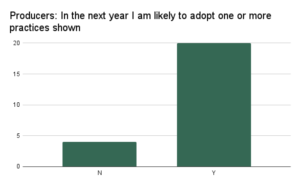
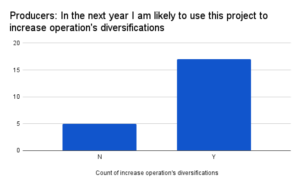
While USHA growers seemed excited about the prospect of mason bees' pollination abilities, they were very skeptical when it came to the cost of ~$250 per acre. With high commercial honey bee mortalities in 2025, we are expecting growers to show more interest in alternative managed bees, and hopefully this presentation left them with the resources they need to pursue mason bee purchasing or renting if they want to. Alternatively, it may be wise to target Utah Horticulturalists for involvement in on-farm research, where they can see the benefits of mason bee pollination by participating in a research study, without having to pay for the bees.
Lastly, I attended the Pacific Branch Entomological Society of America (PBESA) conference and presented a research poster on March 31st, 2025. This poster explained the deeper analytical approach we chose to take when looking at pollen samples from Osmia provisions in strawberries and currants (Figures 2 and 3). During the presenting session, I spoke at length with around 10 academic peers, mainly university researchers, and a one hobby beekeepers. The poster won 1st place in the Master's student competition.
Fact Sheets: 2 (In progress)
High tunnel Pollination Fact Sheet: As a part of Education Objective 2, we planned to compose a fact sheet on mason bee management during the first year. Unfortunately, the primary study aspect we wished to share in that publication (nesting preference results) did not go well during the 2024 field season. We felt that mason bee management practices may still be too preliminary to present in a fact-sheet format, but we are exploring options to share what is known with Utah and Oregon growers, even if our results are not included. Instead, we chose to work on the year 2 fact sheet on high tunnel pollination, following promising results from the 2024 strawberry high tunnel in Utah. We have a nearly finalized draft that should be published well before the final report is due for this grant in March 2026 (see products list).
Blueberry Results One-Pager: In addition to the planned fact sheets, we composed a one-pager to hand to our growers when we set up blueberry sites again in 2025. This document outlines findings from the 2024 season as well as updated plans that are being implemented with the help of the Oregon Blueberry Commission (see products list). We presented these to the 2 farmers we are working with in Oregon this year, and to the 2 USDA collaborators we work with in Oregon.
Press Articles and Newsletters: 2
I worked with a writer for WSARE and published a short interview article about the project, published February 24th, 2025. This article discusses the research project generally without including many results, but does include some information I have gathered from related literature. I also interviewed for an "Orchard Buzz Spotlight" in the Orchard Bee Associations monthly newsletter, published January 7th, 2025. This spotlight was mainly aimed at personal information, but it did mention two aspect of the project: pollination research in berries and the use of Osmia bruneri in bee management.
